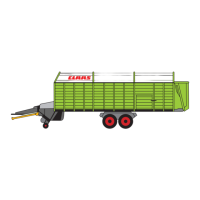TIC QUANTUM Hydraulics
10/04 11-7
All control units are in their neutral position. At the beginning, the swash
plate (17) is in its maximum swung-out position (see also “Motor OFF”)
As soon as the motor is started, the pump delivers the maximum volume
flow to the spools of all control units.
As the spools completely shut off the flow, the pressure rises the acts
upon the right side of the volume flow controller (8) which is moved to the
left against the compression spring (21).
The control edge (25) is now opened, enabling the pressure to access
the top face of the control ram (14). Now the swash plate (17) is moved to
the “Minimum pump capacity” position against the control spring (15).
This process takes 10 milliseconds.
In this pump position, the following happens:
Only such a volume flow is generated that is enough to compensate
leakage losses;
The pressure required for actuation of a consumer is maintained.
Since each control unit is in its neutral position, the load pressure input
(7) is pressureless (connected to the tank). To move the volume flow
controller, the pump pressure only has to overcome the spring (21). The
pressure required for this is xxx bar (see technical data of tractor) and is
referred to as the “Low-pressure standby”.
The pump remains in the “Low-pressure standby” position until a control
unit is actuated. In this position, the pump requires only little drive energy.

